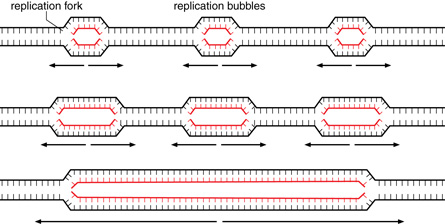Module 7
1. Module 7
1.8. Page 3
Module 7—Molecular Genetics: DNA, RNA, and Protein Synthesis
 Lesson Summary
Lesson Summary
This lesson addressed the following focusing questions:
- How does DNA code our genetic message?
- How do new cells get a copy of this message?
Now you can appreciate how the structure of DNA has led directly to its ability to be copied and how the genetic code can be passed on to the new cells during cell division. The double-stranded DNA can unwind and serve as two template strands. New strands of DNA form to compliment these template strands. Two new, identical molecules of DNA result. Since an original strand of DNA is found in each new DNA molecule, the process is considered semi-conservative.

In this lesson you looked at four important enzymes and how they function in DNA replication. You have learned the difference between the leading and lagging strands and how elongation differs on each of these strands. Throughout this lesson you were asked to think about where errors could occur, causing mistakes in DNA replication. In Lesson 4 these mistakes will be discussed in more detail. In the next lesson you will see how the DNA structure codes for and is used to build proteins used in different structures by cells and bodies, such as muscles, enzymes, and hormones, and to fulfill various functions such as digestion. Do not confuse the process of DNA replication with the process of translation to be discussed in Lesson 3.
Lesson Glossary
Consult the glossary in the textbook for other definitions that you may need to complete your work.
DNA ligase: enzyme that splices together Okazaki fragments during DNA replication of the lagging strand, or sticky ends that have been cut by a restriction endonuclease enzyme
DNA polymerase: an enzyme that slips into the space between two strands of DNA during replication to add DNA nucleotides in order to make complementary strands
DNA replication: the process of creating an exact copy of a molecule of DNA
elongation: the process of joining nucleotides to extend a new strand of DNA; relies on the action of DNA polymerase
genetic code: the order of base pairs in a DNA molecule
genome: the sum, or the entire DNA, carried in an organism’s cells
helicase: an enzyme that breaks segments of DNA during DNA replication; used in technologies to fragment DNA
lagging strand: the strand that is replicated in short segments during DNA replication
leading strand: the strand that is replicated continuously in DNA replication
Okazaki fragments: short nucleotide fragments synthesized during DNA replication of the lagging strand
primase: an enzyme in DNA replication that forms an RNA primer, which is used as a starting point for the elongation of nucleotide chains
replication bubble: oval-shaped, unwound area within a DNA molecule that is being replicated
replication fork: during DNA replication, Y-shaped points at which the DNA helix is unwound and new strands develop
replication origin: specific nucleotide sequence where replication begins
RNA primer: short strand of RNA that is complementary to a DNA template and serves as a starting point for the attachment of new DNA nucleotides
semi-conservative: term used to describe replication where each new molecule of DNA contains one strand of the original complementary DNA, and one new strand, conserving half of the original molecule
termination: the completion of the new DNA strands and the dismantling of the replication machine